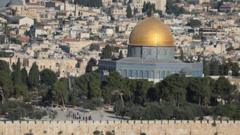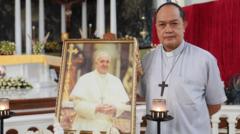BOSTON (AP) — With peak holiday travel starting just after the government shutdown’s flight restrictions, hope for a moment of peace at an airport can feel like a wing and a prayer.
But quiet and worship are just what airport chapels have provided for decades to travelers and to the airport workers that many were originally designed for.
“I love seeing travel bags and workers’ outfits. It gives hope that you’re ministering to a need,” said the Rev. Brian Daley, one of the priests at Our Lady of the Airways at Boston’s Logan International Airport.
Built in the 1950s so that airport employees could attend Mass right in their sprawling workplace, it’s widely considered the first airport chapel in the United States. It’s also among the last to still function as a Catholic church instead of an interfaith space—though Muslim prayer rugs discreetly placed on the rear pews show it welcomes a variety of believers.
Midday on a Friday, a man rolling a carry-on suitcase prayed for a few minutes on a rug in the back of the brick-faced chapel on the ground floor of Terminal C. Donning reflective vests, a sprinkling of airline employees also darted in, knelt in the pews, and hurried back to work after making the sign of the cross with blessed water.
“I come here almost every day to pray for a few minutes,” said Brian Babcock, a Southwest Airlines baggage handler who stopped by Boston’s chapel in his orange vest at the beginning of his shift. “It’s awesome that I have a chapel within walking distance of where I work.”
Workers’ Chapels Open at Airports
The mid-20th-century impetus behind constructing Our Lady of the Airways—along with the two other Catholic chapels that followed at New York’s JFK and Chicago’s O’Hare Airports—stemmed from the church’s desire to reach the faithful in their workplaces.
Earlier, Pope Leo XIII had published the document Rerum Novarum, which inspired church leaders such as Boston’s Cardinal Richard Cushing to start building chapels in various places like train stations and airports.
“He really had a program for establishing chapels for working people,” said James O’Toole, professor emeritus of history at Boston College. “Boston’s Catholicism was overwhelmingly a working-class phenomenon.”
Thousands of people worked at Logan, often on 12-hour shifts spanning Sundays or holy days when Catholics have an obligation to attend Mass, prompting the construction of the chapel.
Despite only one Mass being celebrated at Our Lady on Sundays, it fosters a substantial outreach to the working community.
“They need to be reached in the secular world where they are,” Daley expressed.
From Chapels to Interreligious Meditation Spaces
Protestant and Jewish faith leaders also established chapels at U.S. airports in the 1970s and 80s, primarily providing individual prayer spaces. Over the last three decades, most U.S. airport chapels have transitioned to interfaith spaces.
Wendy Cadge, president and professor of sociology at Bryn Mawr College, stated that new facilities are typically designed more like warm waiting rooms, adapting to contemporary spiritual diversity.
Interfaith Worship Among Taxiing Planes
At Chicago’s O’Hare Airport, a blend of faith resources provide support for a workforce of approximately 50,000, showcasing chaplaincy established since 1960. The current chapel became interfaith, with design features catering to a diverse population.
“Everybody is grateful to have a quiet place to pray,” said Rev. Michael Zaniolo, administrator of the Interfaith Airport Chapels.
Back in Boston, airport employees share the hope that Our Lady of the Airways remains open for travelers and workers seeking solace, reflecting the evolving nature of spiritual practices in bustling airport environments.






















